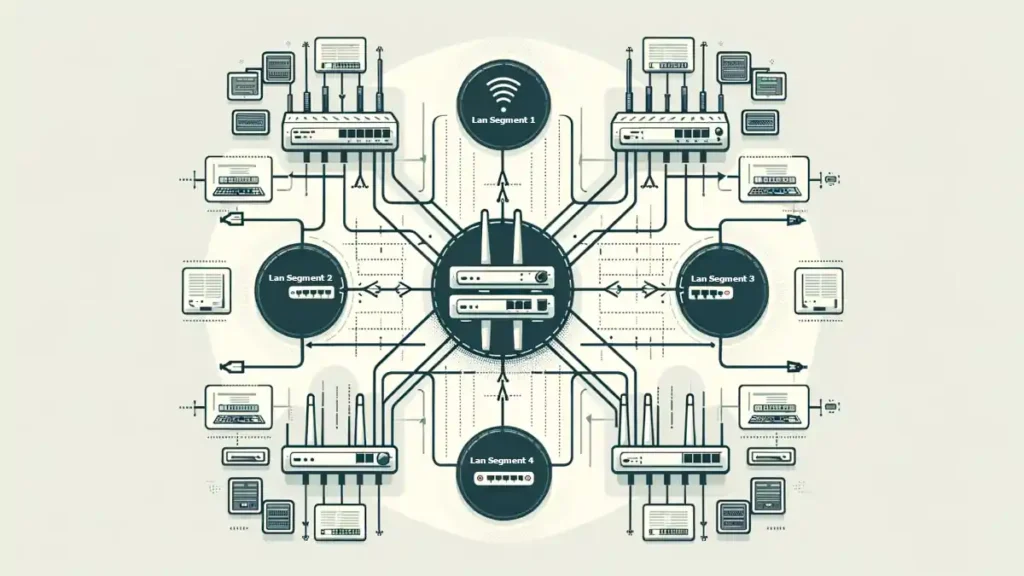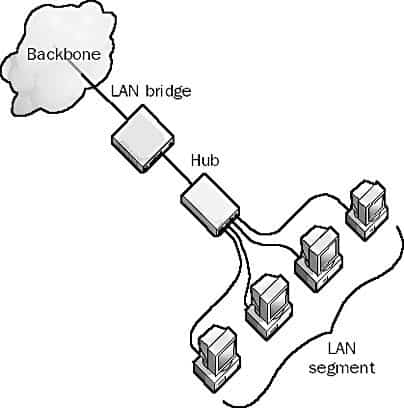Local Area Networks (LANs) form the backbone of modern connectivity within organizational settings. Within these intricate networks, the concept of LAN segments plays a crucial role in maintaining efficient data transfer, reducing congestion, and enhancing overall network performance. This article will delve into the nuances of LAN segments, exploring their definition, significance, and deployment strategies. We will dissect the mechanisms that govern LAN segmentation and its impact on the network’s operational excellence.
Table of Contents:
- What is a LAN Segment?
- The Mechanics of LAN Segmentation
- Evaluating Network Performance Post-Segmentation
- Best Practices for Implementing LAN Segmentation
- LAN Segmentation and Network Security
- The Evolution of LAN Segments in Modern Networking
- Conclusion
- References

1. What is a LAN Segment?
A LAN segment represents a specific, continuous portion of a Local Area Network (LAN). Typically, it includes all devices connected through a shared medium without the intervention of bridging devices. In essence, a LAN segment is a subdivision within a network, often delineated by bridges or routers to streamline traffic flow.
Initially, LANs function as unified networks, yet as the number of connected devices escalates, so does the potential for traffic bottlenecks. Segmentation emerges as a strategic solution to this challenge. By deploying bridges, administrators can isolate sections of the network, creating segments that confine traffic to specific domains.
The rationale is straightforward: isolate traffic to enhance efficiency. When data only traverses the necessary portions of a network, it mitigates the likelihood of collisions and bandwidth competition. Furthermore, segmentation empowers network devices to access the medium with reduced delay, fostering an environment conducive to high performance and reliability.
LAN Segmentation improves performance
Segmentation improves the performance of Ethernet networks by reducing the number of stations in each segment of the LAN that must compete with each other for access to the network. Bridges are generally used for segmenting smaller LANs because they are cheaper and require no special configuration. You place a bridge between your department or workgroup hub and the main network backbone to improve traffic on your local segment.
2. The Mechanics of LAN Segmentation
LAN segmentation is fundamentally about control—controlling traffic to enhance the network’s efficiency and reliability. At the heart of this process lie two pivotal network devices: bridges and routers. Both devices intercept network traffic but differ significantly in their operations and the layers at which they function.

Bridges and Traffic Management
A bridge operates at the Data Link layer (Layer 2) of the OSI model, making decisions based on the MAC (Media Access Control) addresses of devices. By inspecting incoming frames, a bridge can determine if the frame’s destination address is within the same segment. If it is, the frame is kept within that segment; if not, the bridge forwards the frame to the appropriate segment. This behavior reduces unnecessary traffic across various segments, thereby minimizing collisions—a particularly crucial function in networks utilizing the CSMA/CD protocol.
Routers and Segment Differentiation
Routers, functioning at the Network layer (Layer 3), take segmentation further. They manage traffic based on IP addresses, enabling data packets to travel between different subnets—essentially different segments of a network. This not only segregates traffic but also allows for the creation of larger and more complex segmented networks. The routing protocols within routers enable them to learn and communicate pathways, efficiently directing traffic across an inter-network.
3. Evaluating Network Performance Post-Segmentation
Post-segmentation performance evaluation is pivotal for understanding the benefits yielded by segmenting a LAN. Network metrics such as throughput, latency, collision rates, and error rates come into focus. A segmented network often shows improved throughput due to lessened broadcast traffic and fewer collisions. Latency is reduced as well, because data has to travel shorter distances without being held up by congested traffic.
To measure these improvements, network administrators can employ a variety of tools:
- Network Monitors: These tools can track the amount of traffic traversing various segments and identify bottlenecks.
- Protocol Analyzers: Utilized to read the traffic on a network, providing insights into the types and sizes of packets to evaluate efficiency.
- SNMP Managers: These can poll SNMP-enabled devices for traffic statistics, providing a holistic view of network health and efficiency.
4. Best Practices for Implementing LAN Segmentation
Implementing LAN segmentation requires strategic planning to reap maximum performance benefits. Below are some best practices:
- Assess Network Needs: Understand the volume and type of traffic on your network to determine optimal points for segmentation.
- Define Segment Boundaries: Based on traffic patterns and types of devices in use, decide where to place bridges or routers to create effective segments.
- Physical Setup: Deploy bridges and routers in locations where they can best monitor and control the traffic without becoming choke points themselves.
- Configuration: Set up your bridging and routing devices with the proper configurations to ensure they direct traffic as intended.
- Testing and Validation: Before deploying widely, test the segmentation in a controlled environment to validate that traffic flows as expected.
- Documentation and Monitoring: Keep detailed documentation of the segmentation architecture and continuously monitor the network post-implementation for any necessary adjustments.
5. LAN Segmentation and Network Security
Network security is a paramount concern in any organization, and LAN segmentation serves as an effective strategy to enhance it. By dividing a network into smaller, more manageable segments, administrators can limit the scope of broadcast domains and contain the spread of malicious activity.
Containment and Isolation
Each segment acts as a separate collision domain, which also isolates potential security breaches to a confined area. This containment means that an attacker who gains access to one segment does not automatically have access to the entire network.
Policies and Control
Segmentation enables the enforcement of security policies on a segment-by-segment basis. Different segments can have different security protocols depending on their sensitivity and role within the organization.
Reduced Attack Surface
Smaller segments present fewer entry points for attackers, effectively reducing the network’s overall attack surface. This reduced exposure is a key element in a defense-in-depth security strategy.
Improved Monitoring
It’s easier to monitor traffic and detect anomalies when segments are clearly defined. Network administrators can quickly identify and respond to unusual activity, potentially stopping an attack in its tracks.
6. The Evolution of LAN Segments in Modern Networking
The concept of LAN segmentation has undergone significant evolution with the introduction of advanced technologies like Virtual LANs (VLANs). VLANs allow for the logical partitioning of networks at the Data Link layer, extending the segmentation capabilities beyond the physical constraints.
Flexibility and VLANs
VLANs enable network administrators to create segmented broadcast domains within a single switch or across multiple switches, regardless of the physical location of the connected devices. This level of flexibility is crucial in dynamic network environments.
Enhanced Scalability
With VLANs, networks can scale more efficiently. As the network grows, new segments can be added or modified with minimal impact on the existing structure.
Protocol Developments
Accompanying VLANs are protocols like IEEE 802.1Q that facilitate tagging Ethernet frames for specific VLANs, ensuring that traffic is segregated even when it traverses common network infrastructure.
7. Conclusion
LAN segmentation, a time-tested concept, continues to play a critical role in network design for both performance and security. As technologies evolve, so do the methodologies of segmentation, with VLANs and other advances offering more flexibility and control than ever before. The adoption of such technologies must be strategic and well-planned to capitalize on their strengths and integrate seamlessly into the existing network architecture.
8. References
- “Computer Networking: A Top-Down Approach” by James F. Kurose and Keith W. Ross
- “Network Warrior” by Gary A. Donahue
- IEEE 802.1Q Standard for VLAN Tagging
- RFC 8171 – Transparent Interconnection of Lots of Links (TRILL): Clarifications, Corrections, and Updates
- RFC 5517 – Cisco Systems’ Private VLANs: Scalable Security in a Multi-Client Environment